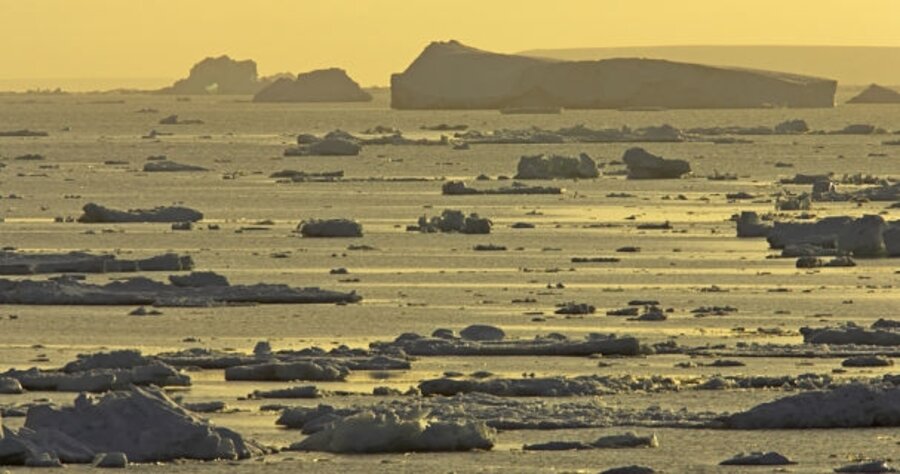It's getting warmer in Antarctica
For years Antarctica has been AWOL when it comes to continent-wide evidence of warming temperatures. Serious warming appeared limited to the Antarctic Peninsula, a mountainous finger of land jutting north toward South America.
No longer, if results from a new study hold up.
The continent is still bitingly frigid and largely a desert. The average annual temperature for the interior is -58 degrees Fahrenheit. Along the coast, it ranges from 5 to 14 degrees F.
But over the past 50 years, the continent as a whole has warmed (or grown less cold, if you like) by an average of 0.2 degrees F. per decade, according to a team led by Eric Steig, a geochemist at the University of Washington in Seattle. The pace is comparable to the rate of warming the southern hemisphere as a whole has undergone during that time, the team notes.
Warming usually seen on the Antarctic Peninsula now appears to extend across all of West Antarctica. The team estimated that temperatures on the peninsula have risen by 0.2 degrees F. per decade. West Antarctica has warmed at a rate of 0.3 degrees F. per decade. And East Antarctica has warmed at a 0.18 degrees F. per decade pace.
The team is a reluctant to unequivocally point a finger at human-triggered global warming just yet. A 50-year record is too short to allow researchers to sort out the relative contribution of human and natural influences to the trends they see at the bottom of the world.
Still, the results "are consistent with the general warming we get from greenhouse gases," says Drew Shindell, a climate-modeler at NASA's Goddard Institute for Space Studies in New York. Dr. Shindell is a member of the research team.
An understatement?
Indeed, the results may understate warming in some areas, suggests Gareth Marshall, a climatologist with the British Antarctic Survey. In an email exchange, he notes that the rate of warming as measured by stations on the Antarctic Peninsula have been somewhat higher than the rate Steig and his colleagues derived.
Still, he offers, the new results illustrate "that over the past 50 years overall, Antarctica has warmed at a similar rate to the rest of the Southern Hemisphere. This suggests that Antarctica, like the six other continents, is being affected by anthropogenic climate change."
Portions of the new results appear to enjoy the beginnings of independent confirmation. A team of scientists from Swansea University and the British Antarctic Survey have found that temperatures at one location in West Antarctica have risen by 0.17 degrees C per decade since 1930. That's virtually identical to the rate Steig's team found for West Antarctica as well.
The British results are estimates based on temperature measurements the team made at various depths in a bore hole they drilled into the Rutford Ice Stream in West Antarctica. The hole is 1,000 feet deep. The results have been accepted for publication in the journal Geophysical Review Letters.
But one bore hole isn't representative of a region, as the researchers readily acknowledge. They call on colleagues to make similar measurements to better pin down the rates and geographic reach of warming in West Antarctica.
Still, the two efforts "complement each other in a very nice way," notes Brian Barrett, the lead author on the Geophysical Review Letters paper.
How they gathered their numbers
Steig and his colleagues had more data to work with. But they faced a problem. Of the 42 stations with records dating as far back as 1957 (the International Geophysical Year), only two sit within the continent's interior. The rest dot the continent's coast. So the team also tapped data from 65 temporary stations that scientists set up periodically for a few years as they conducted research away from long-established sites.
But that's still sparse for an entire continent. So the team tapped satellite data to look at the continent as a whole. Measurements from on high only reach back 25 years. So the team used a statistical approach it developed to turn data from ground and space into a 50-year reconstruction of temperature trends.
Like Dr. Barrett, Steig encourages colleagues to begin taking more bore-hole measurements as an independent test of the results.
Even if the warming rate the team claims for East Antarctica -- higher and colder than the western part of the continent -- turns out to be more iffy than results for other regions of the continent, the results for West Antarctica alone should be a wake-up call, researchers agree. This is the area where large ice shelves are breaking up and the region's ice sheet is thought to be the most vulnerable to melting over the coming centuries if industrial greenhouse-gas emissions and deforestation remain unchecked.





